Adult Case Study: Nursing Priorities and Interventions
VerifiedAdded on 2022/12/26
|12
|3758
|25
AI Summary
This case study focuses on the nursing priorities and interventions for a patient named Reggie who is suffering from heart failure and related symptoms. The study discusses the management of excess fluid volume, high blood pressure, and wound healing. It also emphasizes the importance of patient education for self-management and prevention of recurrence.
Contribute Materials
Your contribution can guide someone’s learning journey. Share your
documents today.
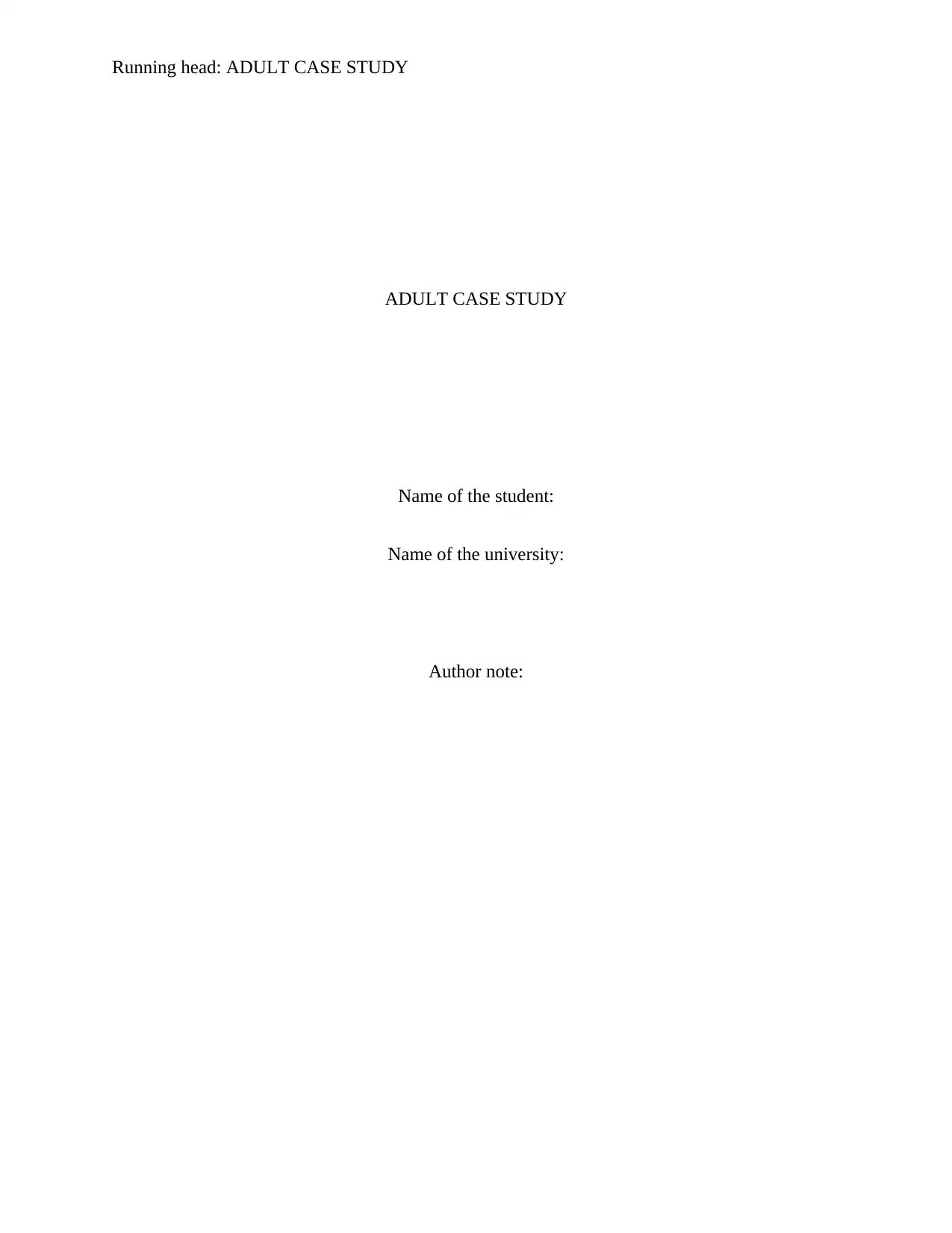
Running head: ADULT CASE STUDY
ADULT CASE STUDY
Name of the student:
Name of the university:
Author note:
ADULT CASE STUDY
Name of the student:
Name of the university:
Author note:
Secure Best Marks with AI Grader
Need help grading? Try our AI Grader for instant feedback on your assignments.

1
ADULT CASE STUDY
The assignment is based on the case study of a patient called Reggie who is 42 year old
and is a native in the nation. He had been transferred to Brisbane with an aim of treatment of his
conditions of acute decomposition of heart failure. This might be mainly because of rheumatoid
heart disorder in the childhood, which had contributed to occurrence of heart failures in the adult
stage. He states that he is facing issue in inspiration and his respiratory rate is found to be 28
breaths per minutes. He is suffering from shortness of breath along with pitting edema and
ascites and is also found to be quite fatigued. His chest on auscultation reveals crackled sounds
and he is also seen to be suffering from high blood pressure. He is also having a wound that he
had got in his workplace and it has now become infected. Clinical reasoning cycle would be used
in this assignment to identify nursing priorities and nursing interventions would be developed
accordingly ensuring that Reggie overcome his suffering and live better quality and safe life.
One of the most concerning symptom that was noticed in Mr. Reggie is his respiratory
issues. He was seen to suffer from shortness of breath and his respiration rate was found to be 28
breaths. The normal respiration rate should be between 12 and 20. Higher respiration rate
signifies that the patient has to put more effort for breathing. In fact, oxygen saturation level is
also found to be 92% when the normal respiration rate should be above 95% (Ibanez et al.,
2017). This shows that his body is devoid of oxygen supply as well. It is important for the nurse
to understand the main pathophysiology that is resulting in abnormality of the breathing patterns
in the patient. Close analysis of the literature showed that the shortness of breath experienced by
Reggie might be attributed to the occurrence of pulmonary edema because of decompensated
heart failure. Pulmonary edema can be explained as the condition when abnormal buildup of
fluid takes place in the lungs and this build up in the lungs can result in the shortness of breath.
In situations when the heart cannot pump the blood efficiently, blood is backed up in the veins
ADULT CASE STUDY
The assignment is based on the case study of a patient called Reggie who is 42 year old
and is a native in the nation. He had been transferred to Brisbane with an aim of treatment of his
conditions of acute decomposition of heart failure. This might be mainly because of rheumatoid
heart disorder in the childhood, which had contributed to occurrence of heart failures in the adult
stage. He states that he is facing issue in inspiration and his respiratory rate is found to be 28
breaths per minutes. He is suffering from shortness of breath along with pitting edema and
ascites and is also found to be quite fatigued. His chest on auscultation reveals crackled sounds
and he is also seen to be suffering from high blood pressure. He is also having a wound that he
had got in his workplace and it has now become infected. Clinical reasoning cycle would be used
in this assignment to identify nursing priorities and nursing interventions would be developed
accordingly ensuring that Reggie overcome his suffering and live better quality and safe life.
One of the most concerning symptom that was noticed in Mr. Reggie is his respiratory
issues. He was seen to suffer from shortness of breath and his respiration rate was found to be 28
breaths. The normal respiration rate should be between 12 and 20. Higher respiration rate
signifies that the patient has to put more effort for breathing. In fact, oxygen saturation level is
also found to be 92% when the normal respiration rate should be above 95% (Ibanez et al.,
2017). This shows that his body is devoid of oxygen supply as well. It is important for the nurse
to understand the main pathophysiology that is resulting in abnormality of the breathing patterns
in the patient. Close analysis of the literature showed that the shortness of breath experienced by
Reggie might be attributed to the occurrence of pulmonary edema because of decompensated
heart failure. Pulmonary edema can be explained as the condition when abnormal buildup of
fluid takes place in the lungs and this build up in the lungs can result in the shortness of breath.
In situations when the heart cannot pump the blood efficiently, blood is backed up in the veins
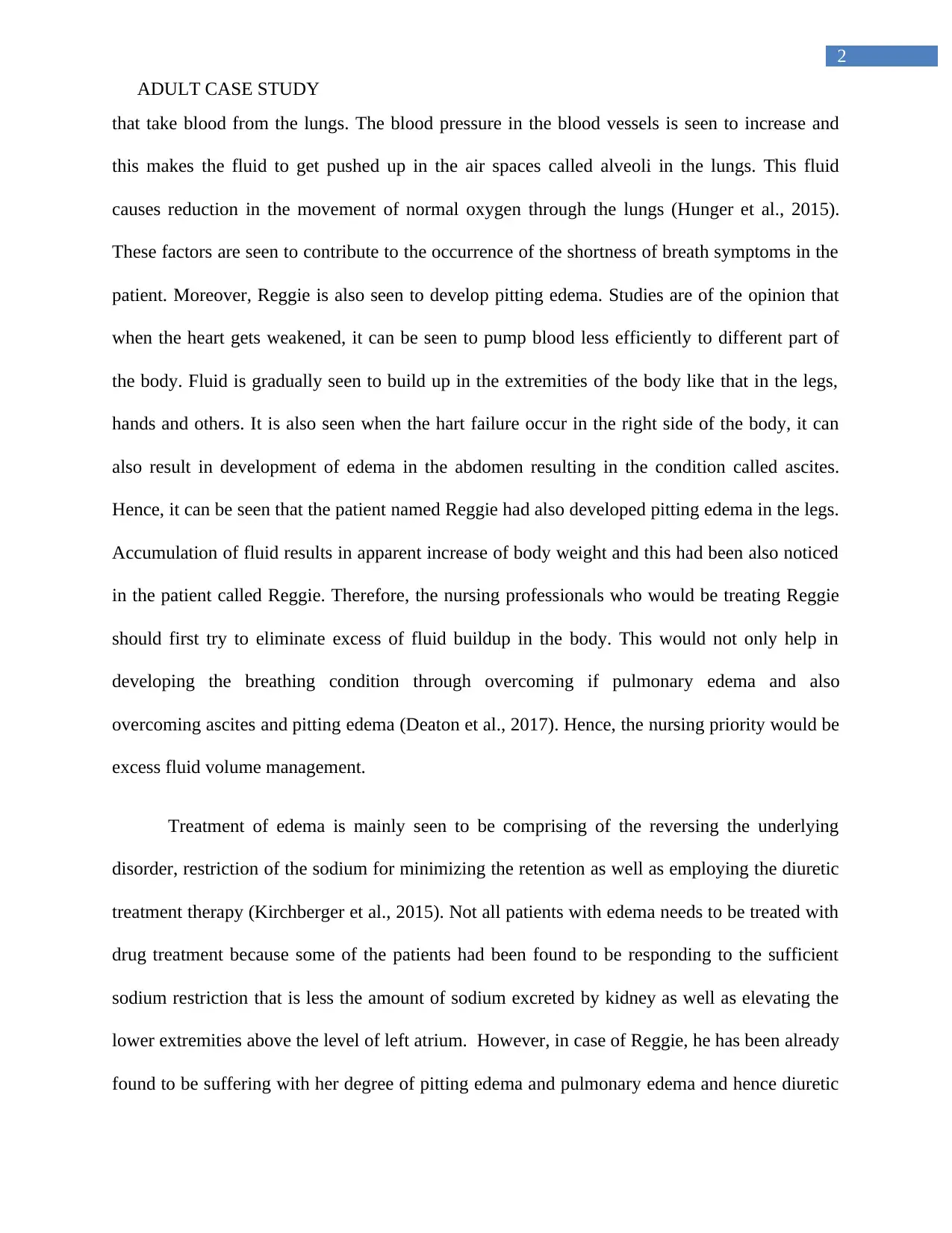
2
ADULT CASE STUDY
that take blood from the lungs. The blood pressure in the blood vessels is seen to increase and
this makes the fluid to get pushed up in the air spaces called alveoli in the lungs. This fluid
causes reduction in the movement of normal oxygen through the lungs (Hunger et al., 2015).
These factors are seen to contribute to the occurrence of the shortness of breath symptoms in the
patient. Moreover, Reggie is also seen to develop pitting edema. Studies are of the opinion that
when the heart gets weakened, it can be seen to pump blood less efficiently to different part of
the body. Fluid is gradually seen to build up in the extremities of the body like that in the legs,
hands and others. It is also seen when the hart failure occur in the right side of the body, it can
also result in development of edema in the abdomen resulting in the condition called ascites.
Hence, it can be seen that the patient named Reggie had also developed pitting edema in the legs.
Accumulation of fluid results in apparent increase of body weight and this had been also noticed
in the patient called Reggie. Therefore, the nursing professionals who would be treating Reggie
should first try to eliminate excess of fluid buildup in the body. This would not only help in
developing the breathing condition through overcoming if pulmonary edema and also
overcoming ascites and pitting edema (Deaton et al., 2017). Hence, the nursing priority would be
excess fluid volume management.
Treatment of edema is mainly seen to be comprising of the reversing the underlying
disorder, restriction of the sodium for minimizing the retention as well as employing the diuretic
treatment therapy (Kirchberger et al., 2015). Not all patients with edema needs to be treated with
drug treatment because some of the patients had been found to be responding to the sufficient
sodium restriction that is less the amount of sodium excreted by kidney as well as elevating the
lower extremities above the level of left atrium. However, in case of Reggie, he has been already
found to be suffering with her degree of pitting edema and pulmonary edema and hence diuretic
ADULT CASE STUDY
that take blood from the lungs. The blood pressure in the blood vessels is seen to increase and
this makes the fluid to get pushed up in the air spaces called alveoli in the lungs. This fluid
causes reduction in the movement of normal oxygen through the lungs (Hunger et al., 2015).
These factors are seen to contribute to the occurrence of the shortness of breath symptoms in the
patient. Moreover, Reggie is also seen to develop pitting edema. Studies are of the opinion that
when the heart gets weakened, it can be seen to pump blood less efficiently to different part of
the body. Fluid is gradually seen to build up in the extremities of the body like that in the legs,
hands and others. It is also seen when the hart failure occur in the right side of the body, it can
also result in development of edema in the abdomen resulting in the condition called ascites.
Hence, it can be seen that the patient named Reggie had also developed pitting edema in the legs.
Accumulation of fluid results in apparent increase of body weight and this had been also noticed
in the patient called Reggie. Therefore, the nursing professionals who would be treating Reggie
should first try to eliminate excess of fluid buildup in the body. This would not only help in
developing the breathing condition through overcoming if pulmonary edema and also
overcoming ascites and pitting edema (Deaton et al., 2017). Hence, the nursing priority would be
excess fluid volume management.
Treatment of edema is mainly seen to be comprising of the reversing the underlying
disorder, restriction of the sodium for minimizing the retention as well as employing the diuretic
treatment therapy (Kirchberger et al., 2015). Not all patients with edema needs to be treated with
drug treatment because some of the patients had been found to be responding to the sufficient
sodium restriction that is less the amount of sodium excreted by kidney as well as elevating the
lower extremities above the level of left atrium. However, in case of Reggie, he has been already
found to be suffering with her degree of pitting edema and pulmonary edema and hence diuretic
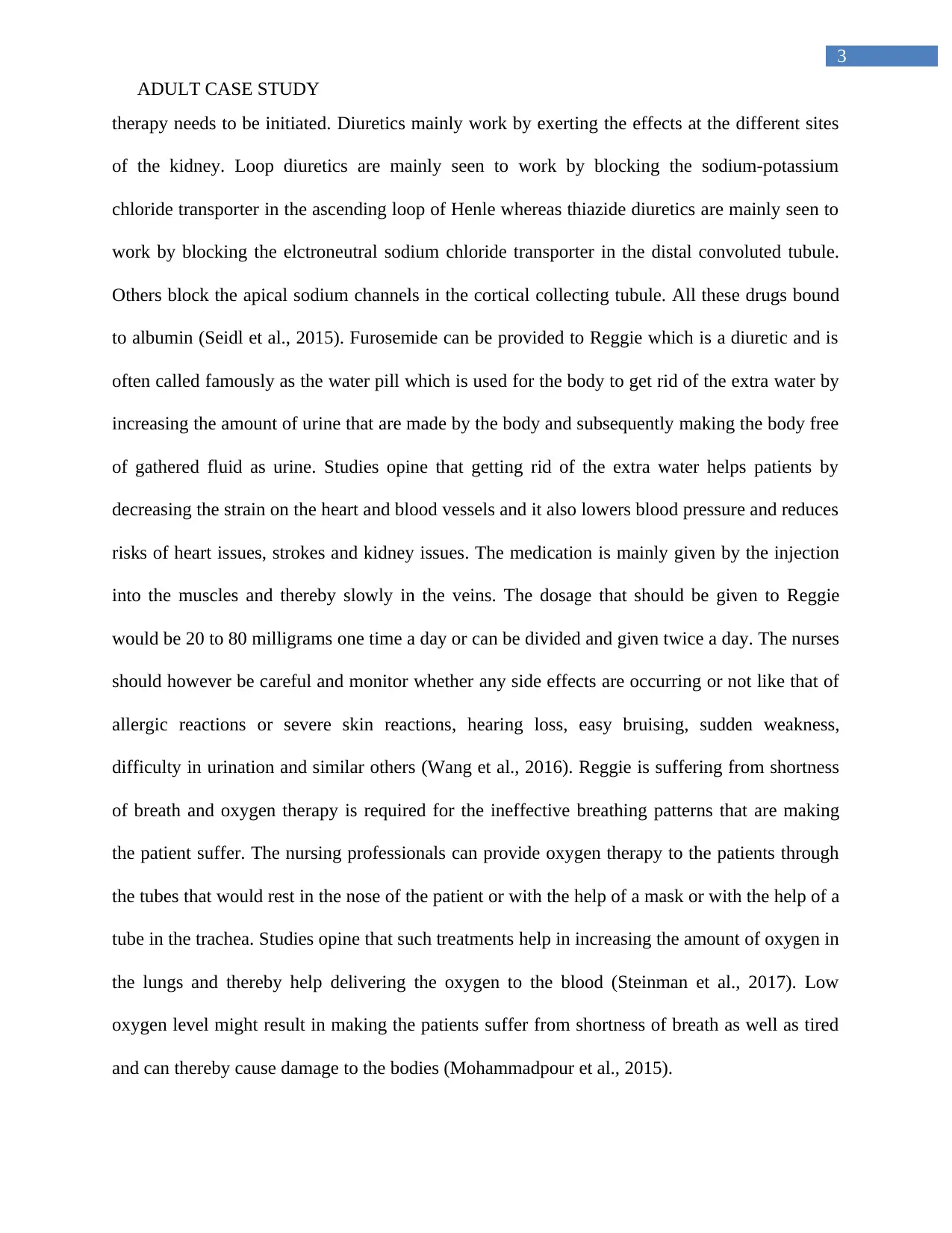
3
ADULT CASE STUDY
therapy needs to be initiated. Diuretics mainly work by exerting the effects at the different sites
of the kidney. Loop diuretics are mainly seen to work by blocking the sodium-potassium
chloride transporter in the ascending loop of Henle whereas thiazide diuretics are mainly seen to
work by blocking the elctroneutral sodium chloride transporter in the distal convoluted tubule.
Others block the apical sodium channels in the cortical collecting tubule. All these drugs bound
to albumin (Seidl et al., 2015). Furosemide can be provided to Reggie which is a diuretic and is
often called famously as the water pill which is used for the body to get rid of the extra water by
increasing the amount of urine that are made by the body and subsequently making the body free
of gathered fluid as urine. Studies opine that getting rid of the extra water helps patients by
decreasing the strain on the heart and blood vessels and it also lowers blood pressure and reduces
risks of heart issues, strokes and kidney issues. The medication is mainly given by the injection
into the muscles and thereby slowly in the veins. The dosage that should be given to Reggie
would be 20 to 80 milligrams one time a day or can be divided and given twice a day. The nurses
should however be careful and monitor whether any side effects are occurring or not like that of
allergic reactions or severe skin reactions, hearing loss, easy bruising, sudden weakness,
difficulty in urination and similar others (Wang et al., 2016). Reggie is suffering from shortness
of breath and oxygen therapy is required for the ineffective breathing patterns that are making
the patient suffer. The nursing professionals can provide oxygen therapy to the patients through
the tubes that would rest in the nose of the patient or with the help of a mask or with the help of a
tube in the trachea. Studies opine that such treatments help in increasing the amount of oxygen in
the lungs and thereby help delivering the oxygen to the blood (Steinman et al., 2017). Low
oxygen level might result in making the patients suffer from shortness of breath as well as tired
and can thereby cause damage to the bodies (Mohammadpour et al., 2015).
ADULT CASE STUDY
therapy needs to be initiated. Diuretics mainly work by exerting the effects at the different sites
of the kidney. Loop diuretics are mainly seen to work by blocking the sodium-potassium
chloride transporter in the ascending loop of Henle whereas thiazide diuretics are mainly seen to
work by blocking the elctroneutral sodium chloride transporter in the distal convoluted tubule.
Others block the apical sodium channels in the cortical collecting tubule. All these drugs bound
to albumin (Seidl et al., 2015). Furosemide can be provided to Reggie which is a diuretic and is
often called famously as the water pill which is used for the body to get rid of the extra water by
increasing the amount of urine that are made by the body and subsequently making the body free
of gathered fluid as urine. Studies opine that getting rid of the extra water helps patients by
decreasing the strain on the heart and blood vessels and it also lowers blood pressure and reduces
risks of heart issues, strokes and kidney issues. The medication is mainly given by the injection
into the muscles and thereby slowly in the veins. The dosage that should be given to Reggie
would be 20 to 80 milligrams one time a day or can be divided and given twice a day. The nurses
should however be careful and monitor whether any side effects are occurring or not like that of
allergic reactions or severe skin reactions, hearing loss, easy bruising, sudden weakness,
difficulty in urination and similar others (Wang et al., 2016). Reggie is suffering from shortness
of breath and oxygen therapy is required for the ineffective breathing patterns that are making
the patient suffer. The nursing professionals can provide oxygen therapy to the patients through
the tubes that would rest in the nose of the patient or with the help of a mask or with the help of a
tube in the trachea. Studies opine that such treatments help in increasing the amount of oxygen in
the lungs and thereby help delivering the oxygen to the blood (Steinman et al., 2017). Low
oxygen level might result in making the patients suffer from shortness of breath as well as tired
and can thereby cause damage to the bodies (Mohammadpour et al., 2015).
Paraphrase This Document
Need a fresh take? Get an instant paraphrase of this document with our AI Paraphraser
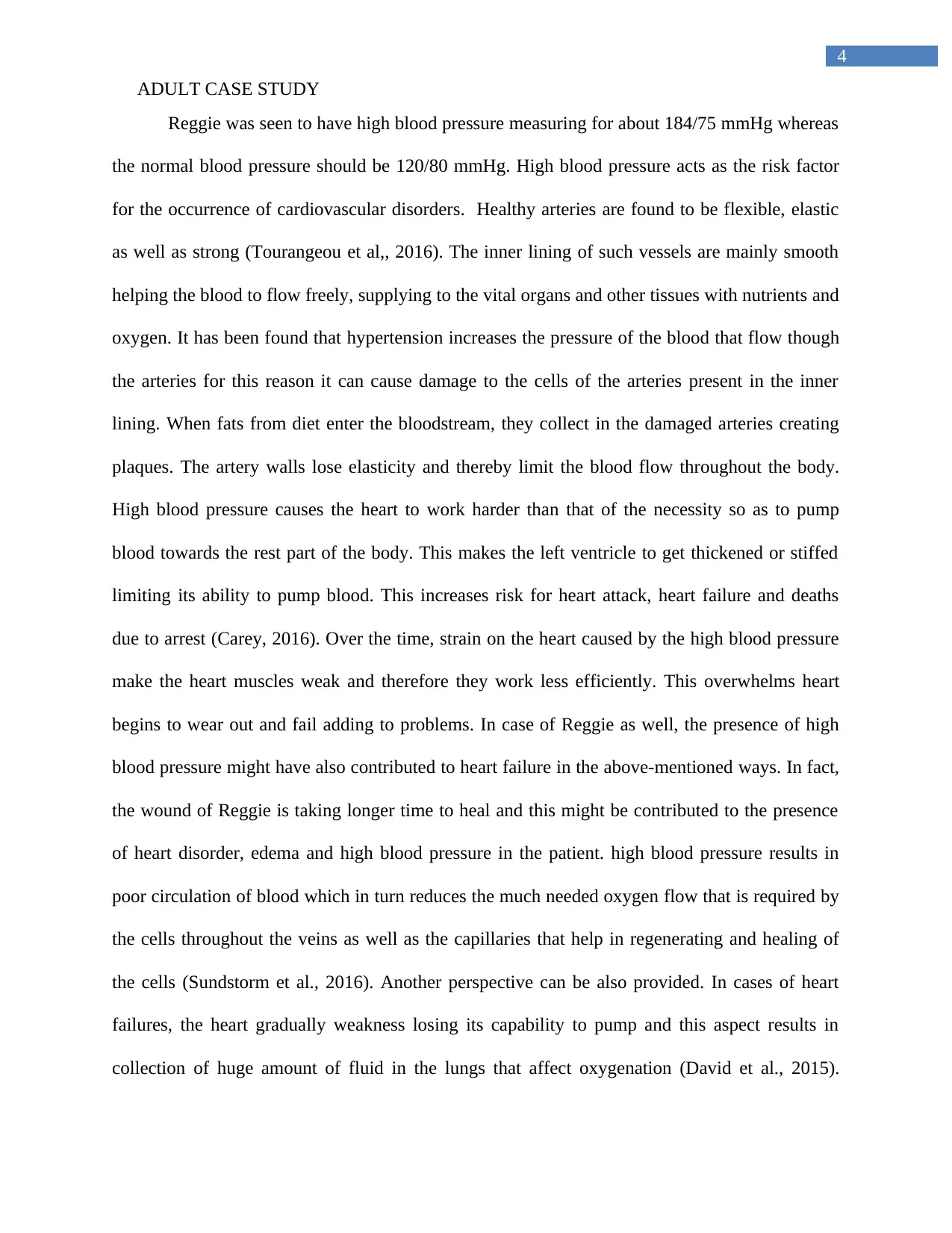
4
ADULT CASE STUDY
Reggie was seen to have high blood pressure measuring for about 184/75 mmHg whereas
the normal blood pressure should be 120/80 mmHg. High blood pressure acts as the risk factor
for the occurrence of cardiovascular disorders. Healthy arteries are found to be flexible, elastic
as well as strong (Tourangeou et al,, 2016). The inner lining of such vessels are mainly smooth
helping the blood to flow freely, supplying to the vital organs and other tissues with nutrients and
oxygen. It has been found that hypertension increases the pressure of the blood that flow though
the arteries for this reason it can cause damage to the cells of the arteries present in the inner
lining. When fats from diet enter the bloodstream, they collect in the damaged arteries creating
plaques. The artery walls lose elasticity and thereby limit the blood flow throughout the body.
High blood pressure causes the heart to work harder than that of the necessity so as to pump
blood towards the rest part of the body. This makes the left ventricle to get thickened or stiffed
limiting its ability to pump blood. This increases risk for heart attack, heart failure and deaths
due to arrest (Carey, 2016). Over the time, strain on the heart caused by the high blood pressure
make the heart muscles weak and therefore they work less efficiently. This overwhelms heart
begins to wear out and fail adding to problems. In case of Reggie as well, the presence of high
blood pressure might have also contributed to heart failure in the above-mentioned ways. In fact,
the wound of Reggie is taking longer time to heal and this might be contributed to the presence
of heart disorder, edema and high blood pressure in the patient. high blood pressure results in
poor circulation of blood which in turn reduces the much needed oxygen flow that is required by
the cells throughout the veins as well as the capillaries that help in regenerating and healing of
the cells (Sundstorm et al., 2016). Another perspective can be also provided. In cases of heart
failures, the heart gradually weakness losing its capability to pump and this aspect results in
collection of huge amount of fluid in the lungs that affect oxygenation (David et al., 2015).
ADULT CASE STUDY
Reggie was seen to have high blood pressure measuring for about 184/75 mmHg whereas
the normal blood pressure should be 120/80 mmHg. High blood pressure acts as the risk factor
for the occurrence of cardiovascular disorders. Healthy arteries are found to be flexible, elastic
as well as strong (Tourangeou et al,, 2016). The inner lining of such vessels are mainly smooth
helping the blood to flow freely, supplying to the vital organs and other tissues with nutrients and
oxygen. It has been found that hypertension increases the pressure of the blood that flow though
the arteries for this reason it can cause damage to the cells of the arteries present in the inner
lining. When fats from diet enter the bloodstream, they collect in the damaged arteries creating
plaques. The artery walls lose elasticity and thereby limit the blood flow throughout the body.
High blood pressure causes the heart to work harder than that of the necessity so as to pump
blood towards the rest part of the body. This makes the left ventricle to get thickened or stiffed
limiting its ability to pump blood. This increases risk for heart attack, heart failure and deaths
due to arrest (Carey, 2016). Over the time, strain on the heart caused by the high blood pressure
make the heart muscles weak and therefore they work less efficiently. This overwhelms heart
begins to wear out and fail adding to problems. In case of Reggie as well, the presence of high
blood pressure might have also contributed to heart failure in the above-mentioned ways. In fact,
the wound of Reggie is taking longer time to heal and this might be contributed to the presence
of heart disorder, edema and high blood pressure in the patient. high blood pressure results in
poor circulation of blood which in turn reduces the much needed oxygen flow that is required by
the cells throughout the veins as well as the capillaries that help in regenerating and healing of
the cells (Sundstorm et al., 2016). Another perspective can be also provided. In cases of heart
failures, the heart gradually weakness losing its capability to pump and this aspect results in
collection of huge amount of fluid in the lungs that affect oxygenation (David et al., 2015).
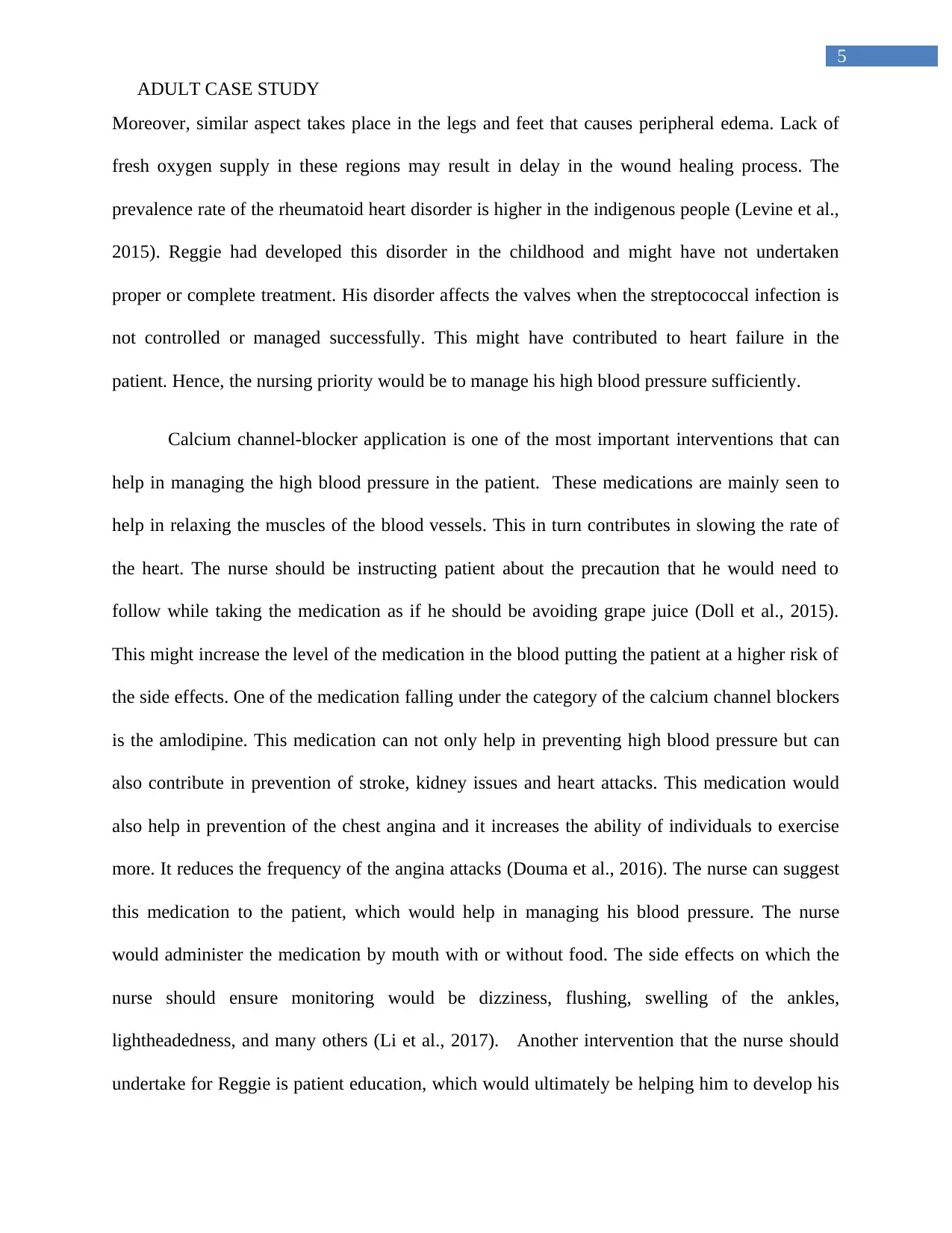
5
ADULT CASE STUDY
Moreover, similar aspect takes place in the legs and feet that causes peripheral edema. Lack of
fresh oxygen supply in these regions may result in delay in the wound healing process. The
prevalence rate of the rheumatoid heart disorder is higher in the indigenous people (Levine et al.,
2015). Reggie had developed this disorder in the childhood and might have not undertaken
proper or complete treatment. His disorder affects the valves when the streptococcal infection is
not controlled or managed successfully. This might have contributed to heart failure in the
patient. Hence, the nursing priority would be to manage his high blood pressure sufficiently.
Calcium channel-blocker application is one of the most important interventions that can
help in managing the high blood pressure in the patient. These medications are mainly seen to
help in relaxing the muscles of the blood vessels. This in turn contributes in slowing the rate of
the heart. The nurse should be instructing patient about the precaution that he would need to
follow while taking the medication as if he should be avoiding grape juice (Doll et al., 2015).
This might increase the level of the medication in the blood putting the patient at a higher risk of
the side effects. One of the medication falling under the category of the calcium channel blockers
is the amlodipine. This medication can not only help in preventing high blood pressure but can
also contribute in prevention of stroke, kidney issues and heart attacks. This medication would
also help in prevention of the chest angina and it increases the ability of individuals to exercise
more. It reduces the frequency of the angina attacks (Douma et al., 2016). The nurse can suggest
this medication to the patient, which would help in managing his blood pressure. The nurse
would administer the medication by mouth with or without food. The side effects on which the
nurse should ensure monitoring would be dizziness, flushing, swelling of the ankles,
lightheadedness, and many others (Li et al., 2017). Another intervention that the nurse should
undertake for Reggie is patient education, which would ultimately be helping him to develop his
ADULT CASE STUDY
Moreover, similar aspect takes place in the legs and feet that causes peripheral edema. Lack of
fresh oxygen supply in these regions may result in delay in the wound healing process. The
prevalence rate of the rheumatoid heart disorder is higher in the indigenous people (Levine et al.,
2015). Reggie had developed this disorder in the childhood and might have not undertaken
proper or complete treatment. His disorder affects the valves when the streptococcal infection is
not controlled or managed successfully. This might have contributed to heart failure in the
patient. Hence, the nursing priority would be to manage his high blood pressure sufficiently.
Calcium channel-blocker application is one of the most important interventions that can
help in managing the high blood pressure in the patient. These medications are mainly seen to
help in relaxing the muscles of the blood vessels. This in turn contributes in slowing the rate of
the heart. The nurse should be instructing patient about the precaution that he would need to
follow while taking the medication as if he should be avoiding grape juice (Doll et al., 2015).
This might increase the level of the medication in the blood putting the patient at a higher risk of
the side effects. One of the medication falling under the category of the calcium channel blockers
is the amlodipine. This medication can not only help in preventing high blood pressure but can
also contribute in prevention of stroke, kidney issues and heart attacks. This medication would
also help in prevention of the chest angina and it increases the ability of individuals to exercise
more. It reduces the frequency of the angina attacks (Douma et al., 2016). The nurse can suggest
this medication to the patient, which would help in managing his blood pressure. The nurse
would administer the medication by mouth with or without food. The side effects on which the
nurse should ensure monitoring would be dizziness, flushing, swelling of the ankles,
lightheadedness, and many others (Li et al., 2017). Another intervention that the nurse should
undertake for Reggie is patient education, which would ultimately be helping him to develop his

6
ADULT CASE STUDY
health literacy level. Thus would help him develop self coping and self-management abilities by
which he can take care of his own health and also protect himself from the recurrence of the
disorder (Rogers & Bush, 2015). The nurse should first teach him about the risk factors, causes,
and consequences of the heart failure that he had developed and thereby undertake motivational
interviewing to make him feel motivated to bring out positive changes in his lifestyles that would
prevent the recurrence of the disorder. The nurse should first teach him the importance of
undertaking healthy fat free diets that are low on salt (DiSante et al., 2017). She can advise him
to take DASH or the Mediterranean diet, which have been already proved to be the best form of
diet for preventing heart disorders and management of high blood pressure. The nurse should
also educate the patient about the importance of the undertaking exercises and physical activities,
which help in managing blood pressure and preventing heart disorders (Currey et al., 2015). The
nurse should also discuss with the patient about the importance of maintaining proper body
weight to prevent obesity and overweight conditions, which are intricately associated with high
blood pressure and development of heart failure. Indigenous people have the customs of smoking
tobacco and drinking alcohol as per of their ancestral traditions (Mesotton et al., 2015). These act
as risk factors for heart disorders and high blood pressure. The nurse should also advise to
overcome such habits to reduce the chances of his recurrence of heart disorder again.
From the above discussion, it can be found that the clinical reasoning cycle indeed acts a
decision-making framework which helps in the collection of the cues from the conditions of the
patients thereby relating them with the patients’ living condition as well as pathophysiology that
undermines the symptoms shown by the patient. Following, this, the nurse can develop nursing
priorities for the patient and accordingly set up nursing goals and develop their action plans. In
case f the patient named Reggie, the nurse had used the clinical reasoning cycle and found put
ADULT CASE STUDY
health literacy level. Thus would help him develop self coping and self-management abilities by
which he can take care of his own health and also protect himself from the recurrence of the
disorder (Rogers & Bush, 2015). The nurse should first teach him about the risk factors, causes,
and consequences of the heart failure that he had developed and thereby undertake motivational
interviewing to make him feel motivated to bring out positive changes in his lifestyles that would
prevent the recurrence of the disorder. The nurse should first teach him the importance of
undertaking healthy fat free diets that are low on salt (DiSante et al., 2017). She can advise him
to take DASH or the Mediterranean diet, which have been already proved to be the best form of
diet for preventing heart disorders and management of high blood pressure. The nurse should
also educate the patient about the importance of the undertaking exercises and physical activities,
which help in managing blood pressure and preventing heart disorders (Currey et al., 2015). The
nurse should also discuss with the patient about the importance of maintaining proper body
weight to prevent obesity and overweight conditions, which are intricately associated with high
blood pressure and development of heart failure. Indigenous people have the customs of smoking
tobacco and drinking alcohol as per of their ancestral traditions (Mesotton et al., 2015). These act
as risk factors for heart disorders and high blood pressure. The nurse should also advise to
overcome such habits to reduce the chances of his recurrence of heart disorder again.
From the above discussion, it can be found that the clinical reasoning cycle indeed acts a
decision-making framework which helps in the collection of the cues from the conditions of the
patients thereby relating them with the patients’ living condition as well as pathophysiology that
undermines the symptoms shown by the patient. Following, this, the nurse can develop nursing
priorities for the patient and accordingly set up nursing goals and develop their action plans. In
case f the patient named Reggie, the nurse had used the clinical reasoning cycle and found put
Secure Best Marks with AI Grader
Need help grading? Try our AI Grader for instant feedback on your assignments.

7
ADULT CASE STUDY
that the nursing priorities for the patient are effective management of the excess fluid in the body
of the patient so that he can overcome his feeling of shortness of breath and other respiratory
issues and overcome the conditions of pitting edema. Another nursing intervention is to manage
his blood pressure level so that further chances of recurrence of hear disorders do not occur and
wound healing also regains back its normal pace. The different interventions for the first nursing
priority would be application of the diuretic therapy and oxygen therapy. The interventions for
the second priority would be application of calcium channel blockers and patient education.
These would help Reggie to overcome his symptoms and help him level better quality life.
ADULT CASE STUDY
that the nursing priorities for the patient are effective management of the excess fluid in the body
of the patient so that he can overcome his feeling of shortness of breath and other respiratory
issues and overcome the conditions of pitting edema. Another nursing intervention is to manage
his blood pressure level so that further chances of recurrence of hear disorders do not occur and
wound healing also regains back its normal pace. The different interventions for the first nursing
priority would be application of the diuretic therapy and oxygen therapy. The interventions for
the second priority would be application of calcium channel blockers and patient education.
These would help Reggie to overcome his symptoms and help him level better quality life.
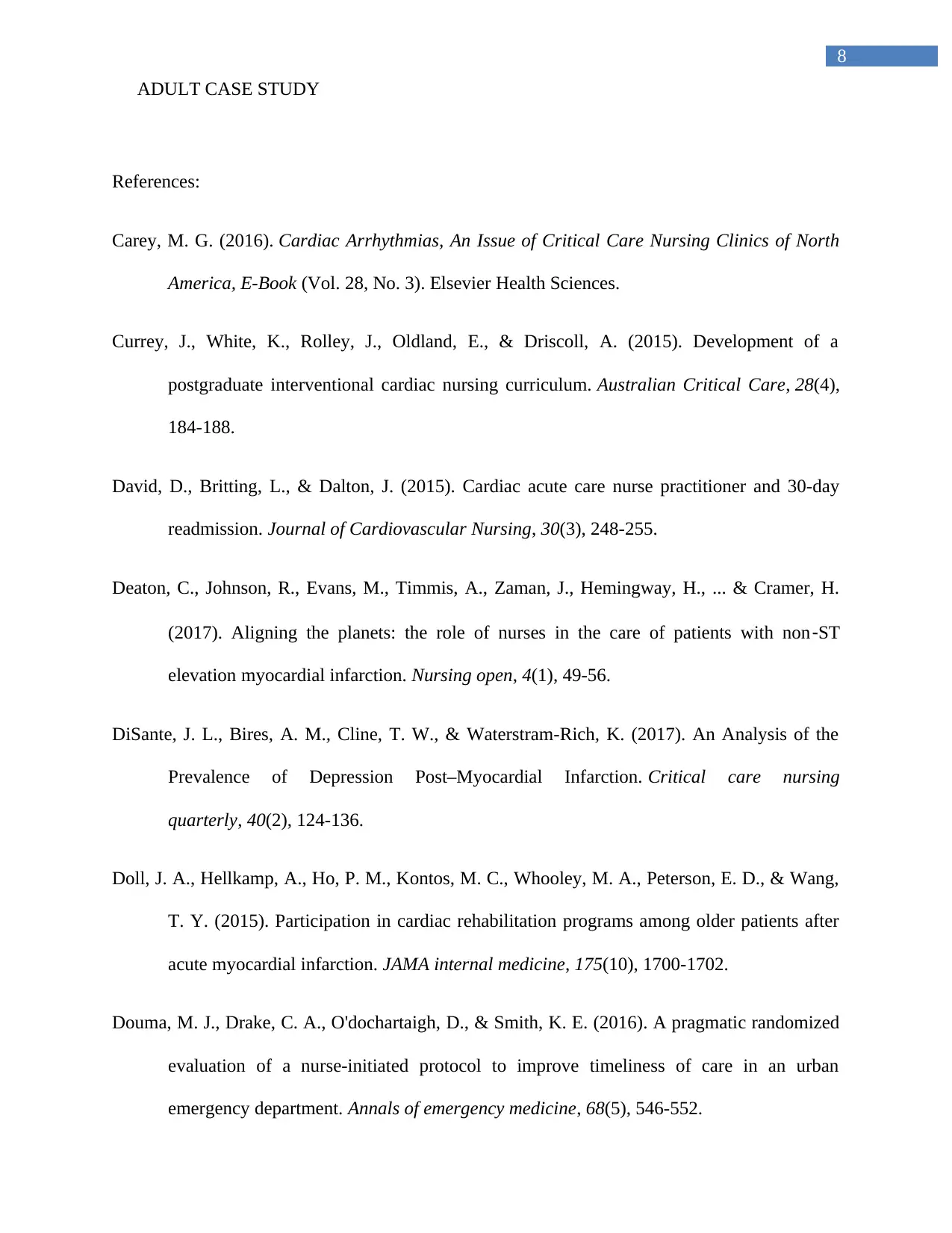
8
ADULT CASE STUDY
References:
Carey, M. G. (2016). Cardiac Arrhythmias, An Issue of Critical Care Nursing Clinics of North
America, E-Book (Vol. 28, No. 3). Elsevier Health Sciences.
Currey, J., White, K., Rolley, J., Oldland, E., & Driscoll, A. (2015). Development of a
postgraduate interventional cardiac nursing curriculum. Australian Critical Care, 28(4),
184-188.
David, D., Britting, L., & Dalton, J. (2015). Cardiac acute care nurse practitioner and 30-day
readmission. Journal of Cardiovascular Nursing, 30(3), 248-255.
Deaton, C., Johnson, R., Evans, M., Timmis, A., Zaman, J., Hemingway, H., ... & Cramer, H.
(2017). Aligning the planets: the role of nurses in the care of patients with non‐ST
elevation myocardial infarction. Nursing open, 4(1), 49-56.
DiSante, J. L., Bires, A. M., Cline, T. W., & Waterstram-Rich, K. (2017). An Analysis of the
Prevalence of Depression Post–Myocardial Infarction. Critical care nursing
quarterly, 40(2), 124-136.
Doll, J. A., Hellkamp, A., Ho, P. M., Kontos, M. C., Whooley, M. A., Peterson, E. D., & Wang,
T. Y. (2015). Participation in cardiac rehabilitation programs among older patients after
acute myocardial infarction. JAMA internal medicine, 175(10), 1700-1702.
Douma, M. J., Drake, C. A., O'dochartaigh, D., & Smith, K. E. (2016). A pragmatic randomized
evaluation of a nurse-initiated protocol to improve timeliness of care in an urban
emergency department. Annals of emergency medicine, 68(5), 546-552.
ADULT CASE STUDY
References:
Carey, M. G. (2016). Cardiac Arrhythmias, An Issue of Critical Care Nursing Clinics of North
America, E-Book (Vol. 28, No. 3). Elsevier Health Sciences.
Currey, J., White, K., Rolley, J., Oldland, E., & Driscoll, A. (2015). Development of a
postgraduate interventional cardiac nursing curriculum. Australian Critical Care, 28(4),
184-188.
David, D., Britting, L., & Dalton, J. (2015). Cardiac acute care nurse practitioner and 30-day
readmission. Journal of Cardiovascular Nursing, 30(3), 248-255.
Deaton, C., Johnson, R., Evans, M., Timmis, A., Zaman, J., Hemingway, H., ... & Cramer, H.
(2017). Aligning the planets: the role of nurses in the care of patients with non‐ST
elevation myocardial infarction. Nursing open, 4(1), 49-56.
DiSante, J. L., Bires, A. M., Cline, T. W., & Waterstram-Rich, K. (2017). An Analysis of the
Prevalence of Depression Post–Myocardial Infarction. Critical care nursing
quarterly, 40(2), 124-136.
Doll, J. A., Hellkamp, A., Ho, P. M., Kontos, M. C., Whooley, M. A., Peterson, E. D., & Wang,
T. Y. (2015). Participation in cardiac rehabilitation programs among older patients after
acute myocardial infarction. JAMA internal medicine, 175(10), 1700-1702.
Douma, M. J., Drake, C. A., O'dochartaigh, D., & Smith, K. E. (2016). A pragmatic randomized
evaluation of a nurse-initiated protocol to improve timeliness of care in an urban
emergency department. Annals of emergency medicine, 68(5), 546-552.
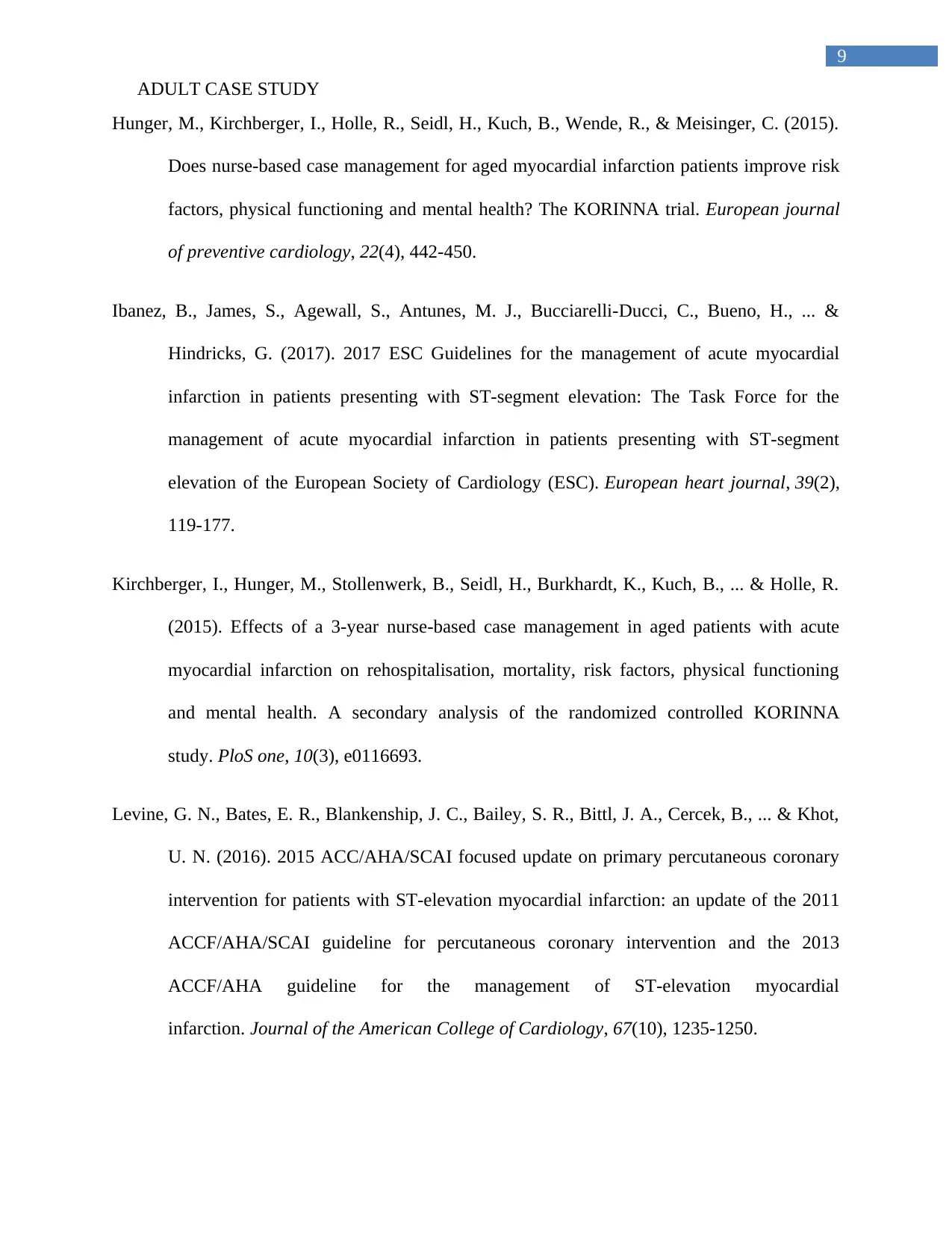
9
ADULT CASE STUDY
Hunger, M., Kirchberger, I., Holle, R., Seidl, H., Kuch, B., Wende, R., & Meisinger, C. (2015).
Does nurse-based case management for aged myocardial infarction patients improve risk
factors, physical functioning and mental health? The KORINNA trial. European journal
of preventive cardiology, 22(4), 442-450.
Ibanez, B., James, S., Agewall, S., Antunes, M. J., Bucciarelli-Ducci, C., Bueno, H., ... &
Hindricks, G. (2017). 2017 ESC Guidelines for the management of acute myocardial
infarction in patients presenting with ST-segment elevation: The Task Force for the
management of acute myocardial infarction in patients presenting with ST-segment
elevation of the European Society of Cardiology (ESC). European heart journal, 39(2),
119-177.
Kirchberger, I., Hunger, M., Stollenwerk, B., Seidl, H., Burkhardt, K., Kuch, B., ... & Holle, R.
(2015). Effects of a 3-year nurse-based case management in aged patients with acute
myocardial infarction on rehospitalisation, mortality, risk factors, physical functioning
and mental health. A secondary analysis of the randomized controlled KORINNA
study. PloS one, 10(3), e0116693.
Levine, G. N., Bates, E. R., Blankenship, J. C., Bailey, S. R., Bittl, J. A., Cercek, B., ... & Khot,
U. N. (2016). 2015 ACC/AHA/SCAI focused update on primary percutaneous coronary
intervention for patients with ST-elevation myocardial infarction: an update of the 2011
ACCF/AHA/SCAI guideline for percutaneous coronary intervention and the 2013
ACCF/AHA guideline for the management of ST-elevation myocardial
infarction. Journal of the American College of Cardiology, 67(10), 1235-1250.
ADULT CASE STUDY
Hunger, M., Kirchberger, I., Holle, R., Seidl, H., Kuch, B., Wende, R., & Meisinger, C. (2015).
Does nurse-based case management for aged myocardial infarction patients improve risk
factors, physical functioning and mental health? The KORINNA trial. European journal
of preventive cardiology, 22(4), 442-450.
Ibanez, B., James, S., Agewall, S., Antunes, M. J., Bucciarelli-Ducci, C., Bueno, H., ... &
Hindricks, G. (2017). 2017 ESC Guidelines for the management of acute myocardial
infarction in patients presenting with ST-segment elevation: The Task Force for the
management of acute myocardial infarction in patients presenting with ST-segment
elevation of the European Society of Cardiology (ESC). European heart journal, 39(2),
119-177.
Kirchberger, I., Hunger, M., Stollenwerk, B., Seidl, H., Burkhardt, K., Kuch, B., ... & Holle, R.
(2015). Effects of a 3-year nurse-based case management in aged patients with acute
myocardial infarction on rehospitalisation, mortality, risk factors, physical functioning
and mental health. A secondary analysis of the randomized controlled KORINNA
study. PloS one, 10(3), e0116693.
Levine, G. N., Bates, E. R., Blankenship, J. C., Bailey, S. R., Bittl, J. A., Cercek, B., ... & Khot,
U. N. (2016). 2015 ACC/AHA/SCAI focused update on primary percutaneous coronary
intervention for patients with ST-elevation myocardial infarction: an update of the 2011
ACCF/AHA/SCAI guideline for percutaneous coronary intervention and the 2013
ACCF/AHA guideline for the management of ST-elevation myocardial
infarction. Journal of the American College of Cardiology, 67(10), 1235-1250.
Paraphrase This Document
Need a fresh take? Get an instant paraphrase of this document with our AI Paraphraser
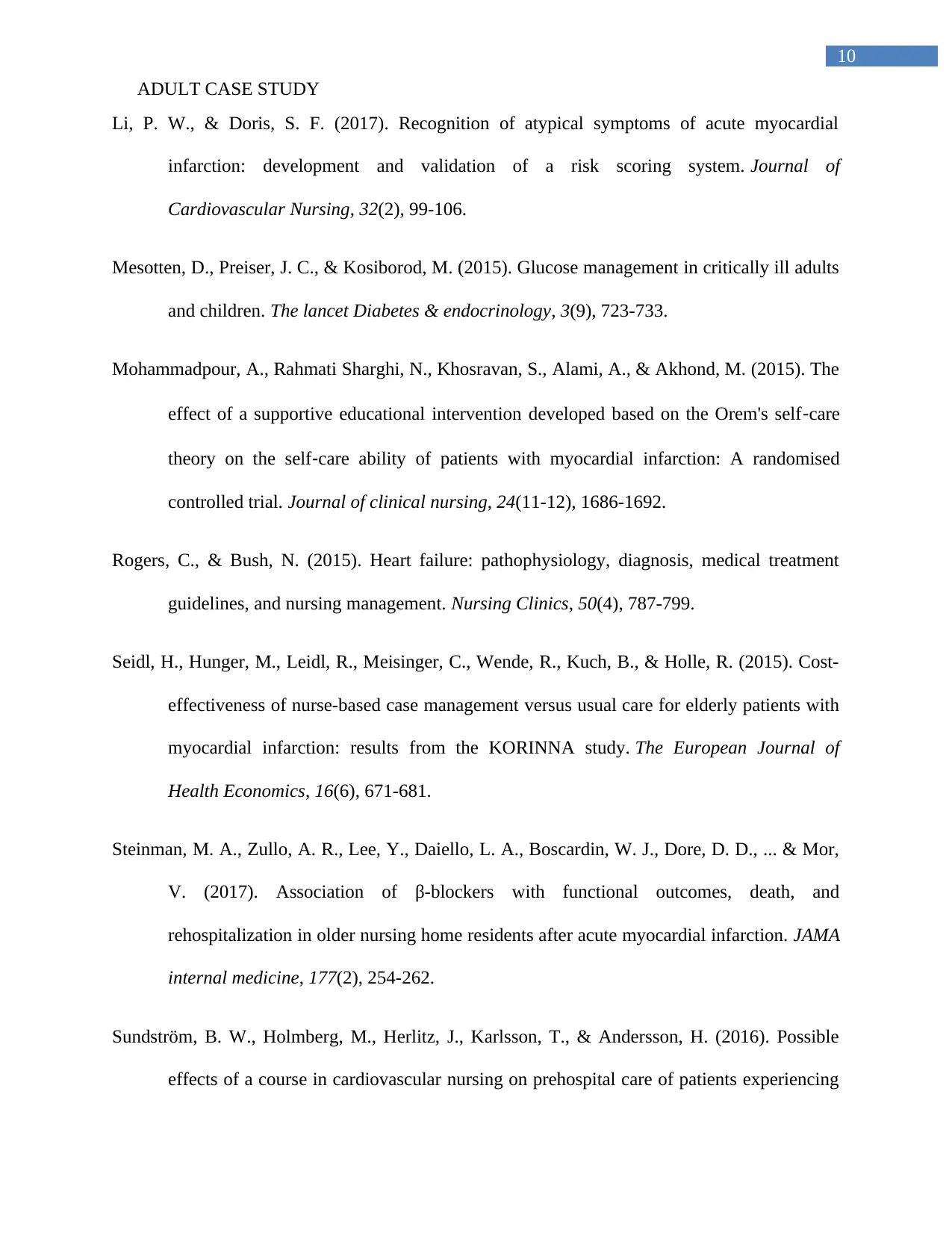
10
ADULT CASE STUDY
Li, P. W., & Doris, S. F. (2017). Recognition of atypical symptoms of acute myocardial
infarction: development and validation of a risk scoring system. Journal of
Cardiovascular Nursing, 32(2), 99-106.
Mesotten, D., Preiser, J. C., & Kosiborod, M. (2015). Glucose management in critically ill adults
and children. The lancet Diabetes & endocrinology, 3(9), 723-733.
Mohammadpour, A., Rahmati Sharghi, N., Khosravan, S., Alami, A., & Akhond, M. (2015). The
effect of a supportive educational intervention developed based on the Orem's self‐care
theory on the self‐care ability of patients with myocardial infarction: A randomised
controlled trial. Journal of clinical nursing, 24(11-12), 1686-1692.
Rogers, C., & Bush, N. (2015). Heart failure: pathophysiology, diagnosis, medical treatment
guidelines, and nursing management. Nursing Clinics, 50(4), 787-799.
Seidl, H., Hunger, M., Leidl, R., Meisinger, C., Wende, R., Kuch, B., & Holle, R. (2015). Cost-
effectiveness of nurse-based case management versus usual care for elderly patients with
myocardial infarction: results from the KORINNA study. The European Journal of
Health Economics, 16(6), 671-681.
Steinman, M. A., Zullo, A. R., Lee, Y., Daiello, L. A., Boscardin, W. J., Dore, D. D., ... & Mor,
V. (2017). Association of β-blockers with functional outcomes, death, and
rehospitalization in older nursing home residents after acute myocardial infarction. JAMA
internal medicine, 177(2), 254-262.
Sundström, B. W., Holmberg, M., Herlitz, J., Karlsson, T., & Andersson, H. (2016). Possible
effects of a course in cardiovascular nursing on prehospital care of patients experiencing
ADULT CASE STUDY
Li, P. W., & Doris, S. F. (2017). Recognition of atypical symptoms of acute myocardial
infarction: development and validation of a risk scoring system. Journal of
Cardiovascular Nursing, 32(2), 99-106.
Mesotten, D., Preiser, J. C., & Kosiborod, M. (2015). Glucose management in critically ill adults
and children. The lancet Diabetes & endocrinology, 3(9), 723-733.
Mohammadpour, A., Rahmati Sharghi, N., Khosravan, S., Alami, A., & Akhond, M. (2015). The
effect of a supportive educational intervention developed based on the Orem's self‐care
theory on the self‐care ability of patients with myocardial infarction: A randomised
controlled trial. Journal of clinical nursing, 24(11-12), 1686-1692.
Rogers, C., & Bush, N. (2015). Heart failure: pathophysiology, diagnosis, medical treatment
guidelines, and nursing management. Nursing Clinics, 50(4), 787-799.
Seidl, H., Hunger, M., Leidl, R., Meisinger, C., Wende, R., Kuch, B., & Holle, R. (2015). Cost-
effectiveness of nurse-based case management versus usual care for elderly patients with
myocardial infarction: results from the KORINNA study. The European Journal of
Health Economics, 16(6), 671-681.
Steinman, M. A., Zullo, A. R., Lee, Y., Daiello, L. A., Boscardin, W. J., Dore, D. D., ... & Mor,
V. (2017). Association of β-blockers with functional outcomes, death, and
rehospitalization in older nursing home residents after acute myocardial infarction. JAMA
internal medicine, 177(2), 254-262.
Sundström, B. W., Holmberg, M., Herlitz, J., Karlsson, T., & Andersson, H. (2016). Possible
effects of a course in cardiovascular nursing on prehospital care of patients experiencing
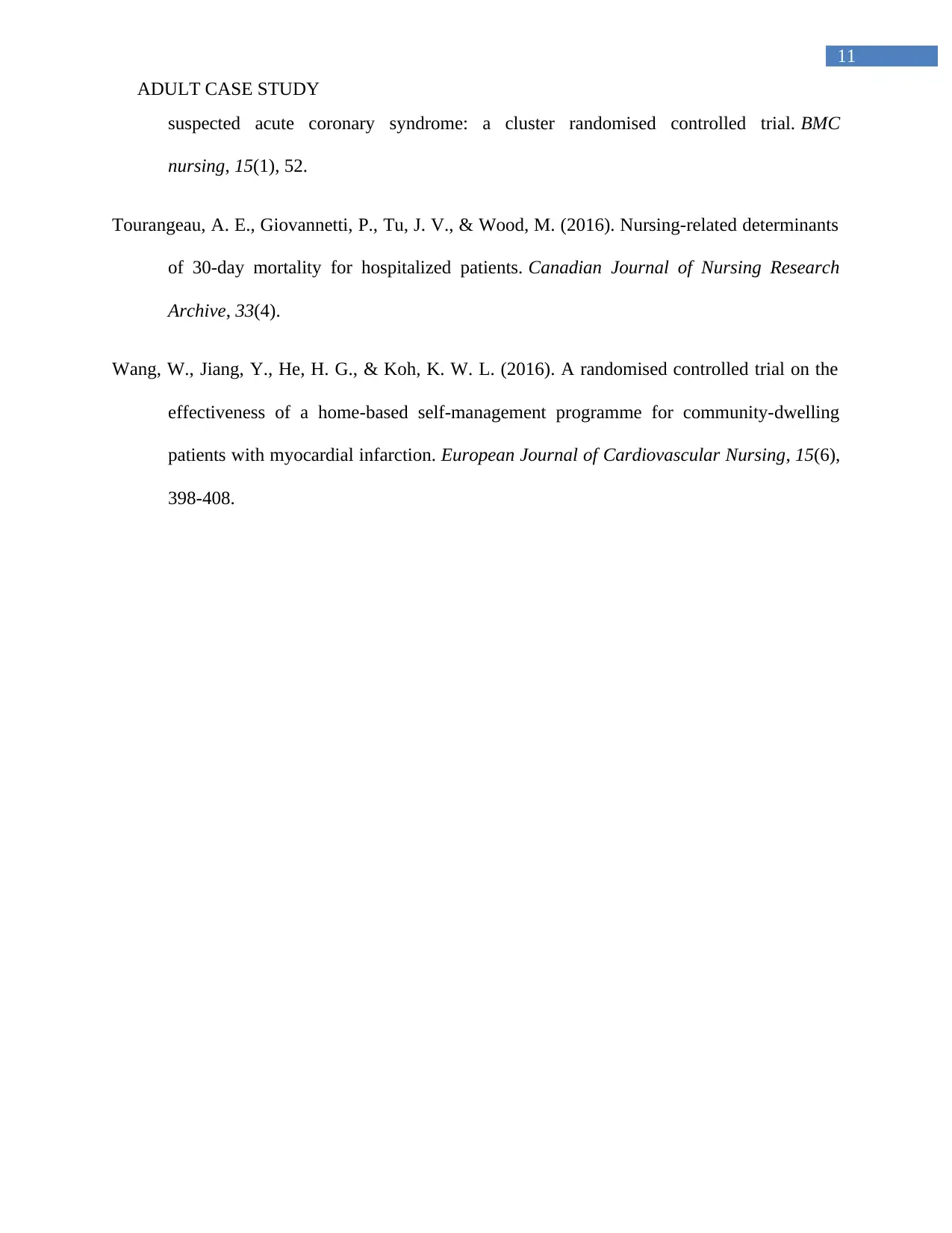
11
ADULT CASE STUDY
suspected acute coronary syndrome: a cluster randomised controlled trial. BMC
nursing, 15(1), 52.
Tourangeau, A. E., Giovannetti, P., Tu, J. V., & Wood, M. (2016). Nursing-related determinants
of 30-day mortality for hospitalized patients. Canadian Journal of Nursing Research
Archive, 33(4).
Wang, W., Jiang, Y., He, H. G., & Koh, K. W. L. (2016). A randomised controlled trial on the
effectiveness of a home-based self-management programme for community-dwelling
patients with myocardial infarction. European Journal of Cardiovascular Nursing, 15(6),
398-408.
ADULT CASE STUDY
suspected acute coronary syndrome: a cluster randomised controlled trial. BMC
nursing, 15(1), 52.
Tourangeau, A. E., Giovannetti, P., Tu, J. V., & Wood, M. (2016). Nursing-related determinants
of 30-day mortality for hospitalized patients. Canadian Journal of Nursing Research
Archive, 33(4).
Wang, W., Jiang, Y., He, H. G., & Koh, K. W. L. (2016). A randomised controlled trial on the
effectiveness of a home-based self-management programme for community-dwelling
patients with myocardial infarction. European Journal of Cardiovascular Nursing, 15(6),
398-408.
1 out of 12
Related Documents
Your All-in-One AI-Powered Toolkit for Academic Success.
+13062052269
info@desklib.com
Available 24*7 on WhatsApp / Email
![[object Object]](/_next/static/media/star-bottom.7253800d.svg)
Unlock your academic potential
© 2024 | Zucol Services PVT LTD | All rights reserved.





